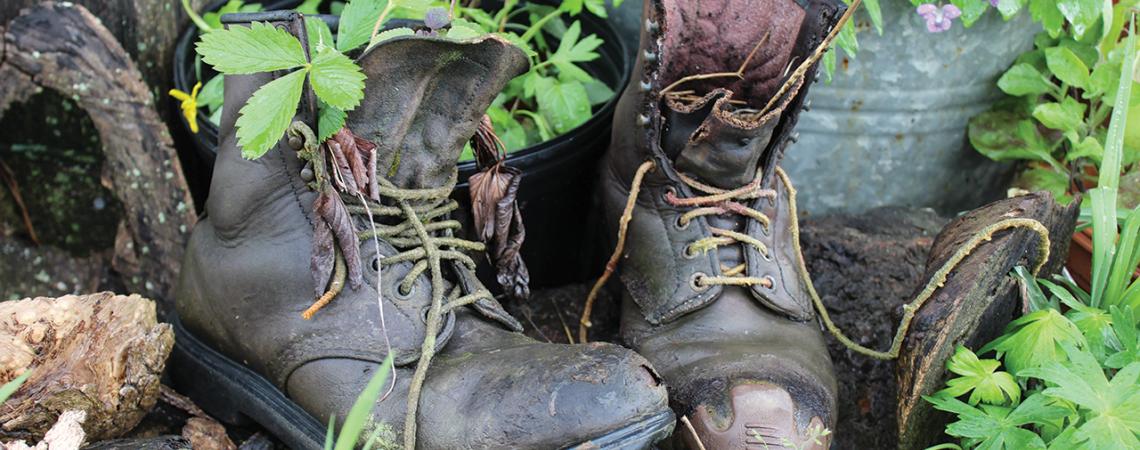Old boots can get a new life as planters in the right setting.
The first containers Kathleen Killilea remembers planting were terra cotta window boxes with cherub embellishments. “My father lifted me over the wall of a client’s garden and handed them to me,” she recalls. Killilea’s job was to place those flower boxes she had helped to plant. She and her brothers played assistant to their dad, who started working at deMonye’s Greenhouse in Columbus when he was 13 years old and grew up to own it.
Her early training paid off. Killilea and her brother Brian, now deMonye’s main operators, have an eye for what makes unusual containers work. Among the traditional flower pots and planters that pepper deMonye’s with a sea of colors are the creative and clever. A child’s wagon becomes a fairy garden of creeping thyme and baby angel tears. Another wagon has a succulent combination. On one wall hangs a tennis racket festooned with sedum.
Longtime employee Denny Kaye is also responsible for these creative approaches — using Big Twister Juncus as hair for a Teenage Mutant Ninja Turtle bucket, and hens and chicks as a Minion hairdo. He’s also created planters from purses, shoes, and even ceramic picture frames, which he often finds at antique malls and flea markets. “If there is an indentation, he will plant a succulent,” laughs Killilea.
DeMonye’s serves as only one greenhouse inspiration; a trip through the yard of Renee and Tony Kropat’s circa-1880s home in Westerville is another bonanza of creativity. Renee’s background as a student at Columbus College of Arts and Design, and later as a gallery owner, honed her ability to see artistic possibility where others might only see junk.
A cast-off couch, for example, has become a succulent bed after Kropat stripped away the fabric covering and reworked some of the springs. A vintage school locker painted orange years ago is planted with purple allium. When a theater’s seats were replaced, Kropat snapped up the old ones for planter conversation pieces. Kropat also thinks big when creating fairy gardens — an old canoe has new life on dry land, as Kropat filled it with dirt, potted flowers, plants, and figurines. Nearby, a full metal bed frame serves as a flower bed, where brightly painted metal cows grin among pink phlox.
Repurposing is Kropat’s passion — turning old wooden stairs upside down for a tiered flower box or perching a sink bowl on a weathered pipe to create a pedestal planter. A ladder festooned with old gardening tools and flower boxes made from weathered wood is a garden eye-catcher. “I try to take an object out of its normal approach,” she says. “I like giving a second, third, or fourth life to something before it ends up in a landfill.”
Creative, unusual planter tips
- Use quality potting medium with a peat moss mixture.
- Good drainage is key. Add a base of rocks to drain excess water. For extra drainage, make holes in the bottom of objects.
- When creating a tiered planter, put plants requiring the most water at the bottom layer, since watering the top will send water to the bottom.
- Plant to location needs. Consider shade or sun — or both.
- Choose plants with the same sun, shade and water needs for the same container.
- Use appropriate container depth. Shallow containers are fine for succulents. Plants with a deeper root system need 4 to 5 inches of soil.
- Vary plants for a mix of textures, heights, and colors for visual appeal.
- Think asymmetrical, fanciful, and fun, but don’t use plants that will hide the container.
- Add embellishments or paint for added interest.
- As temperatures change, replant to have planters last.
Jamie Rhein is a freelance writer from Columbus.









